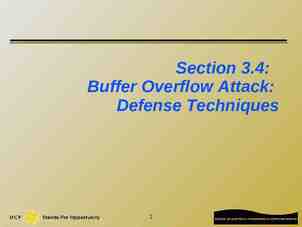Annual Refresher Training Workplace Violence: Preventing and Defusing
18 Slides1.28 MB
Annual Refresher Training Workplace Violence: Preventing and Defusing
Preventing and Defusing Workplace Violence Goals: Understand the scope of workplace violence Know the policy requirements Recognize warning signs of violent behavior Be prepared to take appropriate action
Scope of the Problem Over 2 million victims of workplace violence each year Homicide is second leading cause of job-related deaths
Examples of Violent or Threatening Behavior Verbal abuse Indirect threats Direct threats Nonverbal threats Extreme threats Violent actions
Warning Signs Fascination with weapons Alcohol or drug abuse Severe stress Anguish over employment decisions History of violent incidents
Warning Signs (cont.) Psychological deterioration Decreased or inconsistent job functioning Social isolation Marked deterioration in personal hygiene Other major personality changes
Stages of Violent Behavior Stage 1 – early potential for violence Stage 2 – escalated potential for violence Stage 3 – potential for violence realized
Your Role in Preventing and Defusing Violence Anticipation Security Measures Intervention Reporting
General Security Measures Keep security doors closed and locked Do not share ID cards or security codes with others Follow rules for visitors Report unescorted strangers Report burned out or inadequate lighting
Additional Security Measures Report unusual or unexpected deliveries Report any threats from people outside the company Report any signs of break-ins or missing items Take appropriate precautions when working late If you’re being attacked, yell to alert others
Dealing with an Angry Co-Worker Worker on the right has responded to the angry worker by pointing his finger back and yelling. He is also leaning toward the angry worker. This confrontational style can only make a tense situation worse. Do not argue or raise your voice at the angry worker
Corrected Situation The worker being yelled at is responding to the situation in a better way. He had stepped away from the angry worker. Arms are out to his side is a nonthreatening posture and indicates that he is ready to listen. He is not yelling or even talking and instead is listening to the angry person.
Intervention: Face-to-Face with Violence Warn co-workers and clear the area Call for assistance Try to remain calm and polite Establish eye contact Keep an even tone of voice Maintain a safe distance Determine an escape route
Intervention: Face-to-Face with an Armed Aggressor Don’t try to disarm the aggressor Do what you are told Don’t make any sudden moves Speak carefully and sparingly Go for cover or run only if safe to do so
Incident Reports Date, time, and location Name of aggressor Name of complainant/victim Witnesses Summary of incident Action taken
Helping Victims of Violence Get medical assistance Recognize that pain, fear, stress, and other emotions are natural Don’t blame yourself Seek counseling
Summary Realize that workplace violence is a real and present danger Keep alert for signs of trouble Take security measures Take immediate action to deal with threatening or violent behavior Report all threats or violent behavior Help victims cope with the aftermath of violence
All Done! Make sure you fill out the quiz and drop it off in my mailbox for record keeping. Remember: This is an annual requirement. SEE YOU NEXT YEAR























